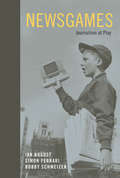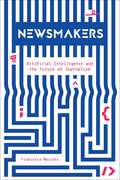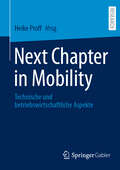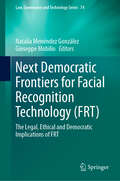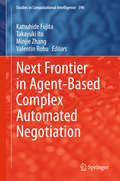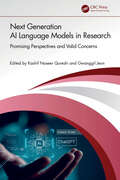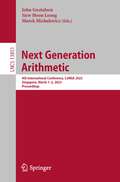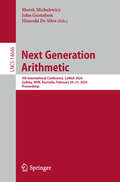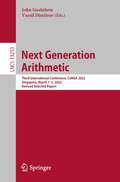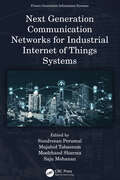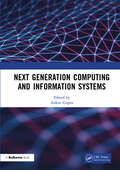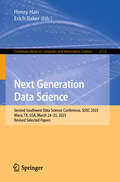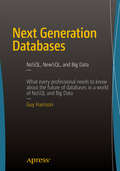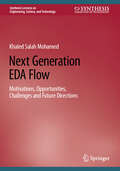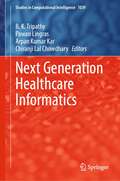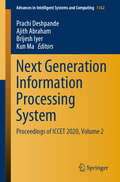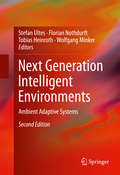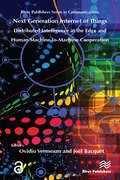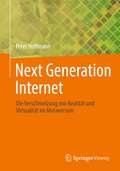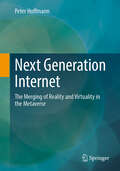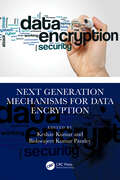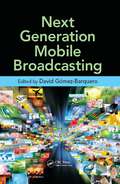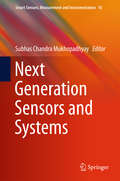- Table View
- List View
Newsgames: Journalism at Play
by Ian Bogost Simon Ferrari Bobby SchweizerHow videogames offer a new way to do journalism.Journalism has embraced digital media in its struggle to survive. But most online journalism just translates existing practices to the Web: stories are written and edited as they are for print; video and audio features are produced as they would be for television and radio. The authors of Newsgames propose a new way of doing good journalism: videogames.Videogames are native to computers rather than a digitized form of prior media. Games simulate how things work by constructing interactive models; journalism as game involves more than just revisiting old forms of news production. Wired magazine's game Cutthroat Capitalism, for example, explains the economics of Somali piracy by putting the player in command of a pirate ship, offering choices for hostage negotiation strategies.Videogames do not offer a panacea for the ills of contemporary news organizations. But if the industry embraces them as a viable method of doing journalism—not just an occasional treat for online readers—newsgames can make a valuable contribution.
Newsmakers: Artificial Intelligence and the Future of Journalism
by Francesco MarconiWill the use of artificial intelligence (AI), algorithms, and smart machines be the end of journalism as we know it—or its savior? In Newsmakers, Francesco Marconi, who has led the development of the Associated Press and Wall Street Journal’s use of AI in journalism, offers a new perspective on the potential of these technologies. He explains how reporters, editors, and newsrooms of all sizes can take advantage of the possibilities they provide to develop new ways of telling stories and connecting with readers.Marconi analyzes the challenges and opportunities of AI through case studies ranging from financial publications using algorithms to write earnings reports to investigative reporters analyzing large data sets to outlets determining the distribution of news on social media. Newsmakers contends that AI can augment—not automate—the industry, allowing journalists to break more news more quickly while simultaneously freeing up their time for deeper analysis. Marshaling insights drawn from firsthand experience, Marconi maps a media landscape transformed by artificial intelligence for the better. In addition to considering the benefits of these new technologies, Marconi stresses the continuing need for editorial and institutional oversight. Newsmakers outlines the important questions that journalists and media organizations should consider when integrating AI and algorithms into their workflow. For journalism students as well as seasoned media professionals, Marconi’s insights provide much-needed clarity and a practical roadmap for how AI can best serve journalism.
Nexie: An AFK Book (Five Nights At Freddy's)
by Kelly Parra Scott Cawthon Andrea WaggenerFive Nights at Freddy's fans won't want to miss this collection of three chilling stories that will haunt even the bravest player...Can you keep a secret? . . . Astrid doesn’t tell anyone about the strange things her Buddytronic doll has been up to. Kara convinces a Pizzaplex employee no one will know if he lets her spend a little more time in the VR attraction. And a Fazbear Entertainment engineer’s custom project has surprises in store for anyone who encounters it. But in the world of Five Nights at Freddy’s, secrets never stay hidden for long . . .In this sixth volume, Five Nights at Freddy's creator Scott Cawthon spins three sinister novella-length tales from uncharted corners of his series' canon. In the world of Five Nights at Freddy's, everything comes with a price to pay.Readers beware: This collection of terrifying tales is enough to rattle even the most hardened Five Nights at Freddy's fans.
Next Chapter in Mobility: Technische und betriebswirtschaftliche Aspekte
by Heike ProffBeim 15. Wissenschaftsforum Mobilität in Duisburg wurde im Mai 2023 über das nächste Kapitel in der Mobilität diskutiert. Der Tagungsband präsentiert dazu Beiträge des Wissenschaftsforums an den Schnittstellen der betriebswirtschaftlichen und ingenieurwissenschaftlichen Forschung und zeigt Möglichkeiten auf, wie Unternehmen und Institutionen Mobilität in Zukunft bedarfsgerecht, ökologisch nachhaltig und ökonomisch rentabel anbieten können.
Next Democratic Frontiers for Facial Recognition Technology: The Legal, Ethical and Democratic Implications of FRT (Law, Governance and Technology Series #74)
by Natalia Menéndez González Giuseppe MobilioThis book focuses on facial recognition technology (FRT) and sheds light on previously unexplored aspects that involve systematic legal issues concerning its regulation, the protection of rights and freedoms, the preservation of democracy and the rule of law. FRT employs cutting-edge AI systems capable of processing biometric data for identification, verification and categorization purposes. Although there have been huge strides in the research and development of these systems in the last few decades and computer scientists are following and supporting this evolution, legal scholars have only been investigating the implications for fundamental rights for the past few years. The introduction of new regulations (especially the European Union AI Act) have turned the debate on its head, putting FRT in the spotlight. However, there are still certain aspects that have not yet been explored but will be crucial in the coming years for the democratic, social, technical, ethical, and legal acceptance of this technology. The contributions gathered here address various legal approaches to FRT that are emerging at the global level. In this regard, they particularly examine how the distinction between private and public entities&’ use of – and consequently also their respective rules on – FRT is becoming increasingly unclear, as some of the latest cases show. Other chapters highlight some of the most challenging and controversial aspects of deploying FRT for specific purposes, such as emotion recognition, and in highly complex contexts, such as smart cities. Furthermore, the papers focus on legal issues stemming from the most recent proposals at the EU level, namely those regarding AI and cybersecurity.
Next Frontier in Agent-based Complex Automated Negotiation (Studies In Computational Intelligence #596)
by Minjie Zhang Takayuki Ito Katsuhide Fujita Valentin RobuThis book focuses on automated negotiations based on multi-agent systems. It is intended for researchers and students in various fields involving autonomous agents and multi-agent systems, such as e-commerce tools, decision-making and negotiation support systems, and collaboration tools. The contents will help them to understand the concept of automated negotiations, negotiation protocols, negotiating agents' strategies, and the applications of those strategies. In this book, some negotiation protocols focusing on the multiple interdependent issues in negotiations are presented, making it possible to find high-quality solutions for the complex agents' utility functions. This book is a compilation of the extended versions of the very best papers selected from the many that were presented at the International Workshop on Agent-Based Complex Automated Negotiations.
Next Generation AI Language Models in Research: Promising Perspectives and Valid Concerns
by Kashif Naseer Qureshi and Gwanggil JeonIn this comprehensive and cutting-edge volume, Qureshi and Jeon bring together experts from around the world to explore the potential of artificial intelligence models in research and discuss the potential benefits and the concerns and challenges that the rapid development of this field has raised.The international chapter contributor group provides a wealth of technical information on different aspects of AI, including key aspects of AI, deep learning and machine learning models for AI, natural language processing and computer vision, reinforcement learning, ethics and responsibilities, security, practical implementation, and future directions. The contents are balanced in terms of theory, methodologies, and technical aspects, and contributors provide case studies to clearly illustrate the concepts and technical discussions throughout. Readers will gain valuable insights into how AI can revolutionize their work in fields including data analytics and pattern identification, healthcare research, social science research, and more, and improve their technical skills, problem-solving abilities, and evidence-based decision-making. Additionally, they will be cognizant of the limitations and challenges, the ethical implications, and security concerns related to language models, which will enable them to make more informed choices regarding their implementation.This book is an invaluable resource for undergraduate and graduate students who want to understand AI models, recent trends in the area, and technical and ethical aspects of AI. Companies involved in AI development or implementing AI in various fields will also benefit from the book’s discussions on both the technical and ethical aspects of this rapidly growing field.
Next Generation Arithmetic: 4th International Conference, CoNGA 2023, Singapore, March 1-2, 2023, Proceedings (Lecture Notes in Computer Science #13851)
by John Gustafson Siew Hoon Leong Marek MichalewiczThis book constitutes the refereed proceedings of the 4th International Conference on Next Generation Arithmetic, CoNGA 2023, held in Singapore, during March 1-2, 2023.The 11 full papers in this book were carefully reviewed and selected from 16 submissions. They were organized in topical sections as follows: Lossless FFTs Using Posit Arithmetic, PLAUs: Posit Logarithmic Approximate Units to Implement Low-Cost Operations with Real Numbers.
Next Generation Arithmetic: 5th International Conference, CoNGA 2024, Sydney, NSW, Australia, February 20–21, 2024, Proceedings (Lecture Notes in Computer Science #14666)
by John Gustafson Marek Michalewicz Himeshi De SilvaThis book constitutes the refereed post-conference proceedings of the 5th International Conference for Next Generation Arithmetic, CoNGA 2024, held in Sydney, NSW, Australia, during February 20–21, 2024. The 5 revised full papers presented were carefully selected from 9 submissions. CoNGA is the leading conference on emerging technologies for computer arithmetic. The demands of both AI and HPC have led the community to realize that something better than traditional floating-point arithmetic is needed to reach the speed, accuracy, and energy-efficiency that are needed for today's most challenging workloads. In particular, posit arithmetic is achieving rapid adoption as a non-proprietary format, but CoNGA welcomes papers about any arithmetic format that breaks from the past and shows merit and promise.
Next Generation Arithmetic: Third International Conference, CoNGA 2022, Singapore, March 1–3, 2022, Revised Selected Papers (Lecture Notes in Computer Science #13253)
by Vassil Dimitrov John GustafsonThis book constitutes the refereed proceedings of the Third International Conference on Next Generation Arithmetic, CoNGA 2022, which was held in Singapore, during March 1–3, 2022. The 8 full papers included in this book were carefully reviewed and selected from 12 submissions. They deal with emerging technologies for computer arithmetic focusing on the demands of both AI and high-performance computing.
Next Generation Communication Networks for Industrial Internet of Things Systems (Future Generation Information Systems)
by Moolchand Sharma Sundresan Perumal Mujahid Tabassum Saju MohananThis book presents Internet of Things (IoT) technology and security-related solutions that employ intelligent data processing technologies and machine learning (ML) approaches for data analytics. It presents practical scenarios from the industry for the application of the internet of things in various domains. Next Generation Communication Networks for Industrial Internet of Things Systems presents concepts and research challenges in communication networking for Industrial internet of things systems. Features: Discusses process monitoring, environmental monitoring, control, and maintenance monitoring. Covers data collection and communication protocols in a comprehensive manner. Highlights the internet of things industrial applications, and industrial revolution 4.0. Presents 5G-enabled internet of things technology and architecture. Showcases artificial intelligence techniques in the IoT networks. It will serve as an ideal reference text for senior undergraduate, graduate students, and academic researchers in the areas of electrical engineering, electronics, and communications engineering, computer engineering, and information technology.
Next Generation Computing Technologies on Computational Intelligence: 4th International Conference, NGCT 2018, Dehradun, India, November 21–22, 2018, Revised Selected Papers (Communications in Computer and Information Science #922)
by Neeraj Kumar Rashmi Sharma Manish Prateek Durgansh Sharma Rajeev Tiwari Kamal KumarThe 18 full and 13 short papers presented were carefully reviewed and selected from 255 submissions. There were organized in topical sections named: Image Processing, Pattern Analysis and Machine Vision; Information and Data Convergence; Disruptive Technologies for Future; E-Governance and Smart World
Next Generation Computing and Information Systems: Proceedings of the 2nd International Conference on Next Generation Computing and Information Systems (ICNGCIS 2023), December 18-19, 2023, Jammu, J&K, India
by Ankur GuptaThe proceedings of the 2nd International Conference on Next-Generation Computing and Information Systems (ICNGCIS'23) includes research papers in diverse emerging domains such as AI, blockchain, web 3.0, metaverse and edge computing apart from traditional domains such as distributed computing and networks and cybersecurity. The proceedings include papers addressing currently relevant research issues such as smart contract security, interoperability in the metaverse, AI applications in healthcare, agriculture and related domains. The proceedings encompass findings with real-world implications for the growth and evolution of modern computing and information systems by addressing various challenges related to their design, deployment, operational aspects, performance and shortcomings. The intended audience for the proceedings of ICNGCIS'23 include researchers from industry and academia, practitioners, students, technology enthusiasts and even general audience looking to explore interesting applications, use-cases and fundamental issues in modern computing and information systems.
Next Generation Data Science: Second Southwest Data Science Conference, SDSC 2023, Waco, TX, USA, March 24–25, 2023, Revised Selected Papers (Communications in Computer and Information Science #2113)
by Henry Han Erich BakerThis book constitutes the refereed proceedings of the Sescond Southwest Data Science Conference, SDSC 2023, held in Waco, TX, USa, during March 24-25, 2023. The 16 full and 1 short paper included in this book were carefully reviewed and selected from 72 submissions. They were oragnized in topical sections named: Business social and foundation data science; and applied data science, artifiicial intelligence and data engineering.
Next Generation Databases
by Guy HarrisonThis is a book for enterprise architects, database administrators, and developers who need to understand the latest developments in database technologies. It is the book to help you choose the correct database technology at a time when concepts such as Big Data, NoSQL and NewSQL are making what used to be an easy choice into a complex decision with significant implications. The relational database (RDBMS) model completely dominated database technology for over 20 years. Today this "one size fits all" stability has been disrupted by a relatively recent explosion of new database technologies. These paradigm-busting technologies are powering the "Big Data" and "NoSQL" revolutions, as well as forcing fundamental changes in databases across the board. Deciding to use a relational database was once truly a no-brainer, and the various commercial relational databases competed on price, performance, reliability, and ease of use rather than on fundamental architectures. Today we are faced with choices between radically different database technologies. Choosing the right database today is a complex undertaking, with serious economic and technological consequences. Next Generation Databases demystifies today's new database technologies. The book describes what each technology was designed to solve. It shows how each technology can be used to solve real word application and business problems. Most importantly, this book highlights the architectural differences between technologies that are the critical factors to consider when choosing a database platform for new and upcoming projects. Introduces the new technologies that have revolutionized the database landscape Describes how each technology can be used to solve specific application or business challenges Reviews the most popular new wave databases and how they use these new database technologies What you'll learn Understand new technologies disrupting the database landscape and powering applications that are changing our lives. Choose the best database technology for the success of your business and projects. Position your career to ride the wave of these new database technologies. Maximize return on investment from NoSQL and other new-wave technologies. Take advantage of next-generation features being incorporated into traditional database products such as Oracle Database and Microsoft SQL Server. Accelerate existing database platforms via new hardware capabilities. Who this book is for Next Generation Databases is a book for software architects, developers, and database professionals who need to understand the next generation of database technologies. Developers and architects need to understand the characteristics of the new wave of databases systems so that they can choose the one which best suits the needs of their current project. Database professionals who want to survive and thrive in increasingly heterogeneous database landscape will find this book a perfect guide to the new architectures and the problems they are best at solving. Table of Contents Part I: The Database Revolution 1. Three Database Revolutions 2. Google, Big Data, and Hadoop 3. Sharding, Amazon, and the Birth of NoSQL 4. Document Databases 5. Graph Databases 6. Columnar Databases 7. SSD and In-Memory Technologies Part II: The Gory Details 8. Distribution and Clustering Models 9. Consistency Models 10. Data Models 11. Data Models and Storage 12. Database of the Future 13. Appendix
Next Generation EDA Flow: Motivations, Opportunities, Challenges and Future Directions (Synthesis Lectures on Engineering, Science, and Technology)
by Khaled Salah MohamedThis book serves as a comprehensive guide to the world of EDA tools, offering readers a deeper understanding of their inner workings and a glimpse into the future of electronic design. With a meticulous focus on numerical methods, the author delves deeply into the mathematical foundations that underpin EDA tools. From finite element analysis to Monte Carlo simulations, readers will gain a thorough understanding of the numerical techniques employed to model and simulate complex electronic systems. Furthermore, this book elucidates the diverse modeling methods utilized in EDA tools, providing readers with a holistic view of the methods employed to represent and analyze electronic circuits and systems. Whether exploring circuit-level simulations or system-level modeling, readers will be equipped with the knowledge needed to navigate the intricacies of EDA toolsets. The author also delves into the fascinating intersection of quantum mechanics and electronic design, examining the evolving landscape of quantum EDA tools and offering insights into the transformative potential of quantum computing in electronic design. Lastly, this book explores the transformative impact of machine learning on EDA tools, offering insights into how artificial intelligence techniques can enhance performance and productivity.
Next Generation Healthcare Informatics (Studies in Computational Intelligence #1039)
by Pawan Lingras Arpan Kumar Kar B. K. Tripathy Chiranji Lal ChowdharyThis edited book provides information on emerging fields of next-generation healthcare informatics with a special emphasis on emerging developments and applications of artificial intelligence, deep learning techniques, computational intelligence methods, Internet of medical things (IoMT), optimization techniques, decision making, nanomedicine, and cloud computing. The book provides a conceptual framework and roadmap for decision-makers for this transformation. The chapters involved in this book cover challenges and opportunities for diabetic retinopathy detection based on deep learning applications, deep learning accelerators in IoT and IoMT, health data analysis, deep reinforcement-based conversational AI agent in healthcare systems, examination of health data performance, multisource data in intelligent medicine, application of genetic algorithms in health care, mental disorder, digital healthcare system with big data analytics, encryption methods in healthcare data security, computation and cognitive bias in healthcare intelligence and pharmacogenomics, guided imagery therapy, cancer detection and prediction techniques, medical image processing for coronavirus, and imbalance learning in health care.
Next Generation Information Processing System: Proceedings of ICCET 2020, Volume 2 (Advances in Intelligent Systems and Computing #1162)
by Ajith Abraham Prachi Deshpande Kun Ma Brijesh IyerThis book gathers high-quality research papers presented at the International Conference on Computing in Engineering and Technology (ICCET 2020) [formerly ICCASP], a flagship event in the area of engineering and emerging next-generation technologies jointly organized by the Dr. Babasaheb Ambedkar Technological University and MGM’s College of Engineering in Nanded, India, on 9-11 January 2020. Focusing on next-generation information processing systems, this second volume of the proceedings includes papers on cloud computing and information systems, artificial intelligence and the Internet of Things, hardware design and communication, and front-end design.
Next Generation Intelligent Environments
by Wolfgang Minker Tobias Heinroth Stefan Ultes Florian NothdurftThis book covers key topics in the field of intelligent ambient adaptivesystems. It focuses on the results worked out within the framework of theATRACO (Adaptive and TRusted Ambient eCOlogies) project. The theoreticalbackground, the developed prototypes, and the evaluated results form a fertileground useful for the broad intelligent environments scientific community aswell as for industrial interest groups. The new edition provides: Chapter authors comment on their work on ATRACO with final remarks as viewed in retrospective Each chapter has been updated with follow-up work emerging from ATRACO An extensive introduction to state-of-the-art statistical dialog management for intelligent environments Approaches are introduced on how Trust is reflected during the dialog with the system
Next Generation Internet of Things – Distributed Intelligence at the Edge and Human-Machine Interactions
by Ovidiu Vermesan Joël BacquetThis book provides an overview of the next generation Internet of Things (IoT), ranging from research, innovation, development priorities, to enabling technologies in a global context. It is intended as a standalone in a series covering the activities of the Internet of Things European Research Cluster (IERC), including research, technological innovation, validation, and deployment.The following chapters build on the ideas put forward by the European Research Cluster, the IoT European Platform Initiative (IoT–EPI), the IoT European Large-Scale Pilots Programme and the IoT European Security and Privacy Projects, presenting global views and state-of-the-art results regarding the next generation of IoT research, innovation, development, and deployment.The IoT and Industrial Internet of Things (IIoT) are evolving towards the next generation of Tactile IoT/IIoT, bringing together hyperconnectivity (5G and beyond), edge computing, Distributed Ledger Technologies (DLTs), virtual/ andaugmented reality (VR/AR), and artificial intelligence (AI) transformation.Following the wider adoption of consumer IoT, the next generation of IoT/IIoT innovation for business is driven by industries, addressing interoperability issues and providing new end-to-end security solutions to face continuous treats.The advances of AI technology in vision, speech recognition, natural language processing and dialog are enabling the development of end-to-end intelligent systems encapsulating multiple technologies, delivering services in real-time using limited resources. These developments are focusing on designing and delivering embedded and hierarchical AI solutions in IoT/IIoT, edge computing, using distributed architectures, DLTs platforms and distributed end-to-end security, which provide real-time decisions using less data and computational resources, while accessing each type of resource in a way that enhances the accuracy and performance of models in the various IoT/IIoT applications.The convergence and combination of IoT, AI and other related technologies to derive insights, decisions and revenue from sensor data provide new business models and sources of monetization. Meanwhile, scalable, IoT-enabled applications have become part of larger business objectives, enabling digital transformation with a focus on new services and applications.Serving the next generation of Tactile IoT/IIoT real-time use cases over 5G and Network Slicing technology is essential for consumer and industrial applications and support reducing operational costs, increasing efficiency and leveraging additional capabilities for real-time autonomous systems.New IoT distributed architectures, combined with system-level architectures for edge/fog computing, are evolving IoT platforms, including AI and DLTs, with embedded intelligence into the hyperconnectivity infrastructure.The next generation of IoT/IIoT technologies are highly transformational, enabling innovation at scale, and autonomous decision-making in various application domains such as healthcare, smart homes, smart buildings, smart cities, energy, agriculture, transportation and autonomous vehicles, the military, logistics and supply chain, retail and wholesale, manufacturing, mining and oil and gas.
Next Generation Internet: Die Verschmelzung von Realität und Virtualität im Metaversum
by Peter HoffmannDie Entwicklung des Internets, insbesondere des WWW, stößt aktuell an ihre Grenzen – sowohl technisch als auch sozio-kulturell und ökonomisch. Als Lösung wird ein neues Internet versprochen, das die Grenzen der realen und der virtuellen Welt überwinden und Realität und Digitalität verschmelzen soll – das Metaversum. Technische, semantische und organisatorische Details greifen hierzu eng ineinander. Was aber bedeutet dies bei genauerer Betrachtung? Welche technisch-technologischen Herausforderungen müssen bewältigt werden, um ein solches Verschmelzen zu erreichen? Welche ökonomischen Möglichkeiten eröffnen sich– und welche verbieten sich möglicherweise? Wie kann erreicht werden, dass ein offenes und für jeden benutzbares Metaversum entsteht? Und wie kann vermieden werden, dass auch in diesem neuen Metaversum wenige große Anbieter ihre proprietären Ideen durchsetzen? Für diese Fragen soll dieses Buch Antworten aufzeigen.
Next Generation Internet: The Merging of Reality and Virtuality in the Metaverse
by Peter HoffmannThe development of the internet, particularly the World Wide Web, is currently hitting its limits—both technically and socio-culturally, as well as economically. A new internet is promised as a solution, one that aims to overcome the boundaries between the real and the virtual world, merging reality and digitality—the metaverse. Technical, semantic, and organizational details are closely intertwined in this context. But what does this mean upon closer examination? What technical and technological challenges must be overcome to achieve such a merging? What economic opportunities arise—and which ones may be precluded? How can we ensure that an open and universally accessible metaverse is created? And how can we prevent a few large providers from imposing their proprietary ideas in this new metaverse? This book aims to provide answers to these questions.
Next Generation Mechanisms for Data Encryption
by Keshav Kumar and Bishwajeet Kumar PandeyThis book gives readers a deep insight into cryptography and discusses the various types of cryptography algorithms used for the encryption and decryption of data. It also covers the mathematics behind the use of algorithms for encryption and decryption.Features Presents clear insight to the readers about the various security algorithms and the different mechanisms used for data encryption. Discusses algorithms such as symmetric encryption, asymmetric encryption, digital signatures, and hash functions used for encryption. Covers techniques and methods to optimize the mathematical steps of security algorithms to make those algorithms lightweight, which can be suitable for voice encryption. Illustrates software methods to implement cryptography algorithms. Highlights a comparative analysis of models that are used in implementing cryptography algorithms. The text is primarily written for senior undergraduates, graduate students, and academic researchers in the fields of electrical engineering, electronics and communications engineering, computer science and engineering, and information technology.
Next Generation Mobile Broadcasting
by David Gomez-BarqueroThis book provides an overview of the past, present, and future in mobile multimedia broadcasting. The first part of the book supplies an overview of the new generation mobile broadcasting technologies currently available. The second part describes the cutting-edge mobile broadcast technology known as DVB-NGH (Digital Video Broadcasting - Next Generation Handheld), which is expected to significantly outperform existing technologies in both capacity and coverage. The book is edited by a member of the DVB-NGH standardization group, and contains contributions from the different standardization groups worldwide.
Next Generation Sensors and Systems
by Subhas Chandra MukhopadhyayWritten by experts in their area of research, this book has outlined the current status of the fundamentals and analytical concepts, modelling and design issues, technical details and practical applications of different types of sensors and discussed about the trends of next generation of sensors and systems happening in the area of Sensing technology. This book will be useful as a reference book for engineers and scientist especially the post-graduate students find will this book as reference book for their research on wearable sensors, devices and technologies.
